
Aralia, or spikenard, is a genus of the family Araliaceae, consisting of 68 accepted species of deciduous or evergreen trees, shrubs, and rhizomatous herbaceous perennials. The genus is native to Asia and the Americas, with most species occurring in mountain woodlands. Aralia plants vary in size, with some herbaceous species only reaching 50 centimetres (20 in) tall, while some are trees growing to 20 metres (66 ft) tall.

Gesneriaceae, the gesneriad family, is a family of flowering plants consisting of about 152 genera and ca. 3,540 species in the tropics and subtropics of the Old World and the New World, with a very small number extending to temperate areas. Many species have colorful and showy flowers and are cultivated as ornamental plants.
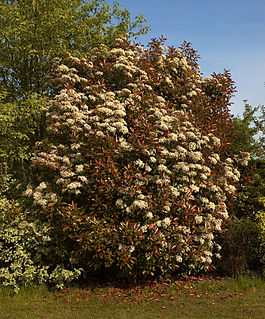
Photinia is a genus of about 30 species of small trees and large shrubs, but the taxonomy has recently varied greatly, with the genera Heteromeles, Stranvaesia and Aronia sometimes included in Photinia.

Androsace, commonly known as rock jasmine, is a genus of flowering plants in the family Primulaceae, second only to Primula in the number of species. It is predominantly Arctic–alpine, with many species in the Himalayas, the mountains of central Asia, the Caucasus, and the southern and central European mountain systems, particularly the Alps and the Pyrenees.

Aeschynanthus is a genus of about 150 species of evergreen subtropical and tropical plants in the family Gesneriaceae. They are usually trailing epiphytes with brightly colored flowers that are pollinated by sunbirds. The genus name comes from a contraction of aischuno and anthos (flower). The common name for some species is lipstick plant, which comes from the appearance of the developing buds emerging from the calyces. A full list of the accepted species and their synonyms can be found in the Smithsonian Institution's World Checklist of Gesneriaceae.

Anaphalis is a genus of herbaceous and woody flowering plants within the family Asteraceae, whose members are commonly known by the name pearl or pearly everlasting. There are around 110 species with the vast majority being native to central and southern Asia. There is one species native to North America that is fairly well known and popular in cultivation, namely the western pearly everlasting.

Cremanthodium is a large genus of flowering plants in the daisy family.
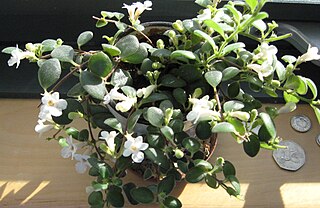
Codonanthe is a genus of mainly epiphytic plants in the family Gesneriaceae, endemic to the Atlantic Forest of Brazil. The botanical name comes from the Ancient Greek for 'bellflower'. They have white or pale pink flowers and somewhat fleshy leaves. In 2013, the genus was reduced in size when more than half of the species were transferred to Codonanthopsis. They can be grown as houseplants, particularly in hanging baskets. Artificial crosses with Nematanthus hybrids have produced the hybrid genus × Codonatanthus.
Briggsia was a genus in the family Gesneriacae that consisted of 22 species of herbaceous perennials, native to the Himalayas, China and Vietnam. The genus is no longer recognized, with all of its member species having been relocated to other genera, including Glabrella, Loxostigma, and Oreocharis.
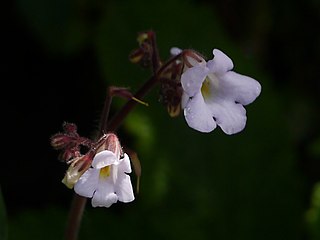
Henckelia is a genus of flowering plants in the family Gesneriaceae. Many of its species were formerly placed in Didymocarpus sect. Orthoboea and in the genus Chirita. Many species formerly placed in Henckelia have been moved to Codonoboea and Loxocarpus.
Sanango is a genus of flowering plants containing a single species, Sanango racemosum. The genus was originally placed in family Loganiaceae but has since been variously placed in Scrophulariaceae, Gesneriaceae and Buddlejaceae. As of 2016 it is considered to be the sister genus to the family Gesneriaceae as previously defined, and the family was tentatively enlarged to include the genus, pending a revision of the families included in Lamiales. It has been placed as the only genus in the monotypic subfamily Sanangoideae.
Fieldia australiana is a species of flowering plant in the family Gesneriaceae. It is a small tree from eastern Australian rainforests. It has also been placed as the sole species in the monotypic genus Lenbrassia.
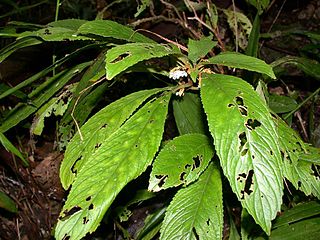
Rhynchotechum is a genus of plants in the family Gesneriaceae, subfamily Didymocarpoideae. Species distribution records are mostly from India, Sri Lanka, China through to southern Japan, Indo-China and Malesia through to New Guinea.
Whytockia is a genus of flowering plants belonging to the family Gesneriaceae.
Tetraphyllum is a genus of flowering plants belonging to the family Gesneriaceae. As of April 2021, there was no consensus as to whether the correct scientific name for the genus is Tetraphyllum or Tetraphylloides, some sources using the former and some the latter.
Lesia is a genus of flowering plants in the family Gesneriaceae, subfamily Gesnerioideae.
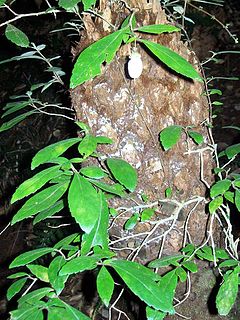
Fieldia is a genus of flowering plants in the family Gesneriaceae, native to New South Wales, Queensland and Victoria in Australia. It has at times been treated as monotypic, with one species, F. australis. Two are accepted as of April 2021 by sources that include Lenbrassia in Fieldia.
Cobananthus is a genus of flowering plants in the family Gesneriaceae, with a single species Cobananthus calochlamys. It is sometimes included in the genus Alloplectus, but molecular phylogenetic studies suggest that the two genera are not closely related, with Cobananthus more closely related to Alsobia.
Rufodorsia is a genus of epiphytic flowering plants in the family Gesneriaceae. The genus name refers to the reddish back of the upper lobes of the flower. The relationship of Rufodorsia with the genus Oerstedina is uncertain, as of April 2021. It is native to montane cloud forest in Central America.
Hemiboea is a genus of flowering plants belonging to the family Gesneriaceae.











